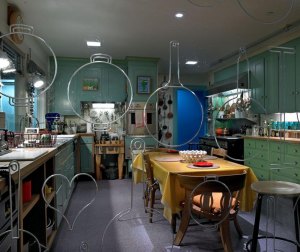25 things to see at the Smithsonian's National Museum of American History

The building initially was called Museum of History and Technology. Its own history began with legislation signed June 28, 1955, by President Dwight D. Eisenhower. The law authorized $36 million for construction of an approximately 750,000-square-foot building that includes three floors for major exhibitions and a lower level with a store and cafeteria. The groundbreaking was held Aug. 22, 1958.
The museum’s current name was adopted in 1980 as a more accurate reflection of its focus on the story of America’s people.
A two-year, $85 million renovation was completed in November 2008. One of the renovation’s most dramatic features is a center atrium with a grand staircase and skylight. The project also included a two-story, glass-enclosed gallery to showcase The Star-Spangled Banner flag, the inspiration for Francis Scott Key’s song, which became the national anthem. Additionally, some of the museum’s exhibit displays were reorganized and refreshed.
The museum is in the midst of another renovation, a $37 million overhaul of the exhibit space in the building’s west wing. The work began in November 2012 and is scheduled to be completed in spring 2015.
That project includes new exhibitions on business and inventions, as well as on American democracy and culture. There will also be an education center, public plazas for special programs, a performance area for chamber music and jazz, and a panoramic window for dramatic views of the Washington Monument and National Mall.
As nice and shiny as new construction is, the weathered, old objects make history museums special. The Smithsonian, of course, has lots of them. The National Museum of American History’s milestone birthday is a good occasion to recognize the particularly cool ones. Below is a list of 25, in no set order. (Not all objects are on display at all times.)
1. The Star-Spangled Banner flag.
2. George Washington artifacts, including a flintlock pistol, his uniform, battle sword and camp chest.
3. Abraham Lincoln artifacts, including a pocket watch, a model submitted with a patent application for a device to make riverboats more buoyant in shallow water (only U.S. president to hold a patent), the top hat he wore to Ford’s Theatre the night of his assassination and an 1886 bronze cast of a plaster life mask made in 1860.
4. The portable lap desk designed by Thomas Jefferson and used to write the Declaration of Independence in 1776.
5. Benjamin Franklin’s walking stick.
6. John Quincy Adams’ ivory cane, presented to him by abolitionists in appreciation of his support.
7. Andrew Jackson’s War of 1812 uniform coat and sword.
8. The two chairs and small table used when Union Gen. Ulysses S. Grant and Confederate Gen. Robert E. Lee met for Lee’s surrender at Appomattox Court House, Va., in April 1865.
9. Radio microphones used by President Franklin D. Roosevelt during his fireside chats in the 1930s.
10. The First Ladies Exhibit.
11. Gunboat Philadelphia, the U.S. Navy’s oldest surviving war vessel. Built in 1776, the 54-foot boat sank later that year during a battle on Lake Champlain in New York. It was discovered and pulled up in 1935.
12. The hunting knife and rifle of Sam Houston, a leader in the Texas War for Independence 1835-36.
13. Union Gen. William T. Sherman’s sword and campaign hat.
14. Lt. Col. George Armstrong Custer’s buckskin coat worn when he was with the U.S. 7th Cavalry in the Dakota Territory in the 1870s.
15. A restored Bell UH-1H “Huey” helicopter that flew over Vietnam in 1966.
16. Gen. Colin Powell’s battle dress uniform in the 1990-91 Gulf War, Operation Desert Storm.
17. Pocket compass used by William Clark, co-leader with Meriwether Lewis of an 1804-06 expedition to explore Western lands acquired in the 1803 Louisiana Purchase.
18. Conestoga covered wagon. From the mid-1700s to the mid-1800s, Conestoga wagons hauled farm produce and supplies across the hinterlands of America.
19. A steam locomotive, named the John Bull, built in 1831. It transported passengers and freight between New York and Philadelphia for 35 years.
20. A telephone used by Alexander Graham Bell for a demonstration of his new technology in Massachusetts on Nov. 26, 1876.
21. A light bulb from Thomas Edison’s first public display of his invention in Menlo Park, N.J., on New Year’s Eve 1879.
22. The Southern Railway’s steam locomotive No. 1401, which operated between 1926 and 1952, primarily serving the Carolinas. This was one of the locomotives that led President Franklin Roosevelt's funeral train from Warm Springs, Ga., where he died, to Washington in April 1945.
23. The ruby slippers worn by Dorothy (Judy Garland) in the 1939 movie, The Wizard of Oz. Red sequins are stand-ins for rubies.
24. The kitchen of cookbook author and TV chef Julia Child. The kitchen, originally in Cambridge, Mass., includes items from the late 1940s through 2001.
25. A section of the lunch counter from the F.W. Woolworth Co. store in Greensboro, N.C., where four African-American college students staged a sit-in Feb. 1, 1960, to protest segregated eating places.
If you would like to comment, contact us or like us on Facebookand tell us what you think.Related:
Photo Gallery: The National Museum of American History turns 50
Michelle Obama's gown from second inauguration displayed at Smithsonian
Anniversaries: Notable Events in American History
Smithsonian plans Star-Spangled event
700-year-old tea jar a work of art

